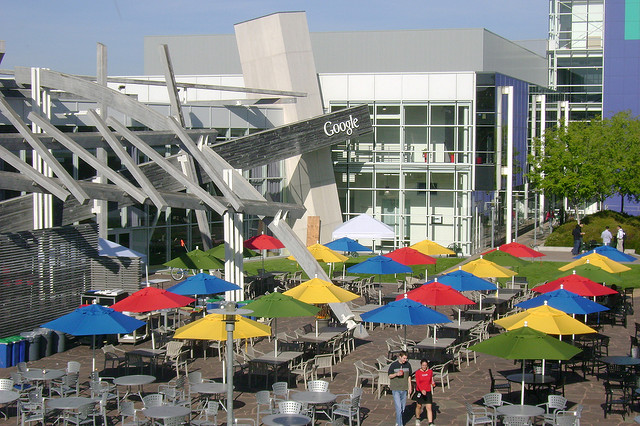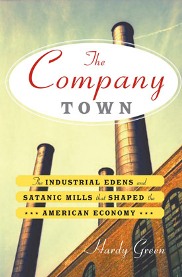
The Company Town: The Industrial Edens and Satanic Mills That Shaped the American Economy
by Hardy Green
–Reviewed by Christine C. Chen
 The word “utopia” has the distinction of being a double agent. It can derive from either the ancient Greek word “ou-topia,” meaning “no place,” or from “eu-topia,” meaning “good place.” Is “utopia,” by its very nature, impossible to achieve? If so, why have we tried, time and time again, to create utopias that are destined only to fail?
The word “utopia” has the distinction of being a double agent. It can derive from either the ancient Greek word “ou-topia,” meaning “no place,” or from “eu-topia,” meaning “good place.” Is “utopia,” by its very nature, impossible to achieve? If so, why have we tried, time and time again, to create utopias that are destined only to fail?
Hardy Green’s The Company Town takes on the question through a history of single-employer communities in America, beginning with the textile mills of the Industrial Revolution and on to the corporate campuses of the present day.
The company town – in which one business dominates the population, sometimes in more than just economic terms – initially arose out of a “paternalistic” recognition that workers needed not only proximate, affordable housing, but also spiritual and educational guidance to accompany their improved economic situations. But by the turn of the century, the predominant model of the company town was one in which workers were largely left alone, except for being forced to shop at the “company store,” where prices were drastically marked-up.
Such towns embodied what Green identifies as two concurrent strains of American capitalism – one socially benign and utopian, believing industrialism to be the source of a better life for all. It was the idealized free market that Adam Smith believed would lead to “universal opulence.” We might better remember Smith for his infamous call for “life, liberty and the pursuit of property.” That’s the other strain of American capitalism – “Exploitationville,” focusing only on profits for management. In charting the sometimes lofty, sometimes breathtakingly brutal motivations of the men who helmed some of America’s biggest and most iconic companies – such as Hershey, Corning and U.S. Steel – Green describes both the best and the worst of which men are capable. Their persistent – and singularly American – faith in self-improvement could lead to either utopian idealism or pure self-interest.
As borne out by certain industries, namely steel and coal, the latter turned out to be the case. The history of coalminers and steelworkers in America is a sad one, marked by regular and often very violent confrontations between organized labor and companies. Or as steel man Henry Clay Frick summed it up before a bloody 1892 shootout and strike: “I can hire half of the working class to shoot the other half.” The comment was indicative of management’s attitude toward the working class, an attitude that did not change much over the next century and that left regions of the rural South in deep poverty even as steel and coal executives reaped huge profits. U.S. Steel, which had adopted a laissez-faire approach toward its company town of Gary, Indiana – all the while forcing its workers to endure twelve-hour shifts – stood by and watched as their home base steadily declined and finally achieved the notorious distinction of being the most dangerous city in America in 1996.
This was a far cry from the view of some of America’s earliest captains of industry, who, in setting up their textile mills, saw it as their responsibility to provide housing, moral and civic education, and opportunity for the benighted workers. As one of the mill founders approvingly noted in the early 19th century, “The contrast in the character of our manufacturing population compared with that of Europe has been the admiration of the most intelligent strangers who have visited us.” And this paternalistic impulse wasn’t just a bygone vestige in the 20th century, even after the Industrial Revolution had swept through the country and capitalism had become America’s raison d’être. Milton Hershey’s town of Hershey, Pennsylvania, offered its resident workers college scholarships, parks, sports venues, a community center, and other amenities, all while the company continued to make sizable profits.
Still, as Green points out, “There can be no such utopias without prosperity.” Both the utopian and the exploitative companies tended to falter in the same moment, during depressions and industry declines. Once profits started to fall, layoffs and wage cuts inevitably followed, and the accompanying social unrest led to bitter clashes. Management found that its attempts to “socially engineer” more orderly, obedient citizens in company towns were for naught the instant that workers felt that their livelihoods were being threatened, and increasingly, such corporate moral policing was viewed with suspicion. And once the automobile entered the picture, company towns became less necessary and even undesirable.
That the utopian and exploitative strains of capitalism can co-exist – and even rise and fall together – raises probing questions about who we were, who we are and where we want to be. We might be heartened that companies and business schools are starting to educate executives and workers in social entrepreneurship and social responsibilities. And one gleaming example of the recent revival of the “good company town,” the Googleplex, suggests that wooing workers with first-class amenities and a “code of conduct” that proclaims, “Don’t be evil,” can result in record profits and happy employees.
And regardless of whether corporate motivations are more strategic than idealistic, companies now know they’re under the constant glare of the public eye and government agencies. James Madison knew centuries ago that “If men were angels, no government would be necessary.” The history of American capitalism surely suggests that however angelic we might think we are, we strive and fail because we’re all too human.
Buy the book: Skylight, Powell’s, Amazon, Borders.
Further Reading: There is Power in a Union: The Epic Story of Labor in America by Philip Dray and Building the Workingmans Paradise: The Design of American Company Towns by Margaret Crawford.
Christine C. Chen teaches humanities at St. John’s College in Santa Fe, New Mexico and is also a professional violinist.
*Photo of the Googleplex courtesy Maria Ly.




Send A Letter To the Editors